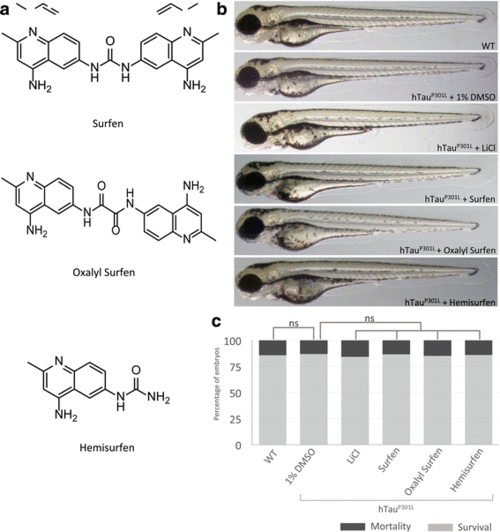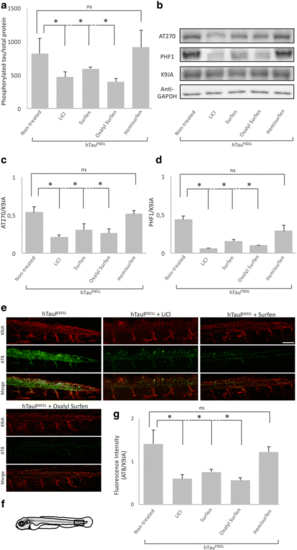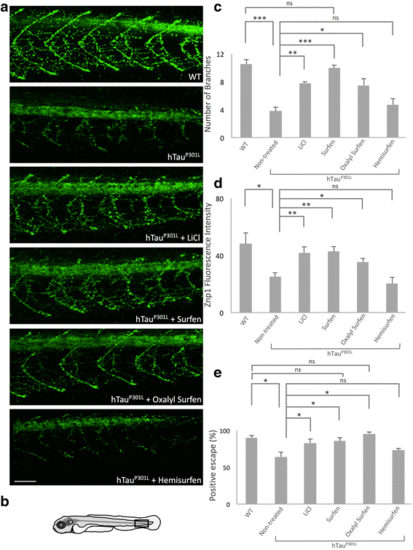- Title
-
Surfen and oxalyl surfen decrease tau hyperphosphorylation and mitigate neuron deficits in vivo in a zebrafish model of tauopathy
- Authors
- Naini, S.M.A., Yanicostas, C., Hassan-Abdi, R., Blondeel, S., Bennis, M., Weiss, R.J., Tor, Y., Esko, J.D., Soussi-Yanicostas, N.
- Source
- Full text @ Transl Neurodegener
|
Surfen and oxalyl surfen are well tolerated by Tg[HuC::hTauP301L; DsRed] embryos. a Chemical structure of Surfen (1,3-bis(4-amino-2-methylquinolin-6-yl) urea), oxalyl surfen (N1,N2- bis(4-amino-2-methylquinolin-6-yl)oxalamide) and hemisurfen (1-(4-amino-2-methylquinolin-6- yl)urea). b Phenotypic analysis of 72 hpf wild-type (WT) and Tg[HuC::hTauP301L; DsRed] (hTauP301L) embryos incubated for 2 days in E3 medium containing 1% DMSO (hTauP301L?+?1% DMSO), 80 mM LiCl (hTauP301L?+?LiCl), 3 ?M surfen (hTauP301L?+?surfen), 2 ?M oxalyl surfen (hTauP301L?+?oxalyl surfen) or 3 ?M hemisurfen (hTauP301L?+?hemisurfen), showed that embryonic development is not impaired by the treatments. Magnification ×?40. c Survival rate of 72 hpf wild-type (WT) and Tg[HuC::hTauP301L; DsRed] (hTauP301L) embryos incubated for 2 days in E3 medium containing 1% DMSO (hTauP301L?+?1% DMSO), 80 mM LiCl (hTauP301L?+?LiCl), 3 ?M surfen (hTauP301L?+?surfen), 2 ?M oxalyl surfen (hTauP301L?+?oxalyl surfen), or 3 ?M hemisurfen (hTauP301L?+?hemisurfen), demonstrated that embryonic mortality was not significantly increased by treatments (n?=?250, P?>?0.05, Student?s t test) |
|
Treatments with surfen and oxalyl surfen, but not hemisurfen, decrease tau hyperphosphorylation in Tg[HuC::hTauP301L; DsRed] embryos in vivo. a ELISA quantification of pThr181 in 72 hpf Tg[HuC::hTauP301L; DsRed] (hTauP301L) embryos treated for 2 days in E3 medium containing 1% DMSO (hTauP301L?+?1% DMSO), 80 mM LiCl (hTauP301L?+?LiCl), 3 ?M surfen, (hTauP301L?+?surfen), 2 ?M oxalyl surfen (hTauP301L?+?oxalyl surfen), or 3 ?M hemisurfen (hTauP301L?+?hemisurfen). The values were normalized to total human Tau protein recovered in each sample. pThr181 was significantly decreased in Tg[HuC::hTauP301L; DsRed] embryos treated with LiCl, surfen and oxalyl surfen, but not hemisurfen (* P?<?0.05, ns: not significant, Student?s t test). b Western blot analysis of pThr181 (AT270 antibody), pSer396/pSer404 (PHF1 antibody) and total-Tau (K9JA antibody) in 1% DMSO 72 hpf Tg[HuC::hTauP301L; DsRed] (hTauP301L) embryos and in age-matched siblings treated for 2 days with 80 mM LiCl, 3 ?M surfen, 2 ?M oxalyl surfen or 3 ?M hemisurfen, confirmed that treatments with surfen or oxalyl surfen, but not hemisurfen, markedly reduce tau hyperphosphorylation in Tg[HuC::hTauP301L; DsRed] embryos. c Densitometric analysis of AT270 on Western blots (represented in b) showing significant decrease of AT270/K9JA densitometric intensity ratio with LiCl, surfen and oxalyl surfen treatment, but not hemisurfen (n?=?3, * P?<?0.05, ns: non-significant, Student?s t test). d Densitometric analysis of PHF1 staining intensity on Western blots (represented in b) showing significant decrease of PHF1/K9JA densitometric intensity ratio with LiCl, surfen and oxalyl surfen treatment, but not hemisurfen (n?=?3, * P?<?0.05, ns: non-significant, Student?s t test). e Immunohistochemical visualization of total hTau protein (K9JA) and hyperphosphorylated tau epitope pSer202/pThr205 (AT8), and merged images of the two labelings (merge) in framed caudal area (f) in spinal cord of 72 hpf Tg[HuC::hTauP301L; DsRed] embryos and age-matched siblings incubated for 2 days with 80 mM LiCl (hTauP301L?+?LiCl), 3 ?M surfen (hTauP301L?+?surfen), 2 ?M oxalyl surfen (hTauP301L?+?oxalyl surfen) or 3 ?M hemisurfen (hTauP301L?+?hemisurfen), confirmed the decrease of tau hyperphosphorylation following treatments with surfen and oxalyl surfen. g Quantification of AT8 fluorescence intensity. The AT8/K9JA fluorescence intensity ratio was significantly decreased following treatments with LiCl, surfen and oxalyl surfen, but not hemisurfen (n?=?10, * P?<?0.05, ns: non-significant, Student?s t test). Scale bar: 50 ?m |
|
Surfen and oxalyl surfen rescue motoneuron defects and functional deficits in Tg[HuC::hTauP301L; DsRed] embryos. a Immunohistochemical visualization of the synaptotagmin II protein (anti-znpl antibody) in 72 hpf wild-type (WT) and Tg[HuC::hTauP301L; DsRed] (hTauP301L) embryos treated for 2 days with 1% DMSO (hTauP301L?+?1% DMSO), 80 mM LiCl (hTauP301L?+?LiCl), 3 ?M surfen (hTauP301L?+?surfen), 2 ?M oxalyl surfen (hTauP301L?+?oxalyl surfen) or 3 ?M hemisurfen (hTauP301L?+?hemisurfen), showed that surfen and oxalyl surfen markedly rescued the motorneuron axon defects seen in Tg[HuC::hTauP301L; DsRed] embryos. The imaged caudal area corresponds to the box represented in (b). Scale bar: 50 ?m. c Quantification of the mean axonal branch number in the framed caudal area (b) of Tg[HuC::hTauP301L; DsRed] embryos treated as in (a). The number of axonal branches was significantly increased in Tg[HuC::hTauP301L; DsRed] embryos treated with surfen and oxalyl surfen when compared with their age-matched 1% DMSO siblings (n?=?10, ***P?<?0.001; **P?<?0.01; *P?<?0.05; ns: non-significant, Student?s t test). d Quantification of fluorescence staining intensity of znp1 labeling in the framed caudal area (b) of Tg[HuC::hTauP301L; DsRed] embryos treated as in (a). Results showed that the fluorescence intensity of the znp1 staining was significantly increased in Tg[HuC::hTauP301L; DsRed] embryos following surfen and oxalyl surfen treatments when compared with their age-matched 1% DMSO siblings (n?=?10, **P?<?0.01; *P?<?0.05, ns: non-significant, Student?s t test). e The touch evoked escape response was used to probe the motor behavior of Tg[HuC::hTauP301L; DsRed] embryos treated for 1 day with 80 mM LiCl, 3 ?M surfen, 2 ?M oxalyl surfen or 3 ?M hemisurfen. The motor defect observed in Tg[HuC::hTauP301L; DsRed] embryos was significantly rescued following treatment with surfen and oxalyl surfen, but not hemisurfen (n?=?250, *P?<?0.05, ns: non-significant, Student?s t test) |



